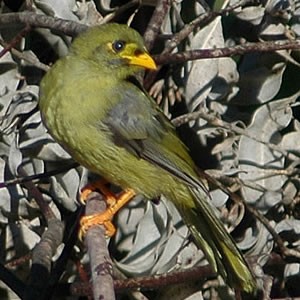Bell Miner
A species of Australian miners Scientific name : Manorina melanophrys Genus : Australian miners
Bell Miner, A species of Australian miners
Botanical name: Manorina melanophrys
Genus: Australian miners
Content
Description General Info
 Photo By Brett Donald , used under CC-BY-SA-2.5 /Cropped and compressed from original
Photo By Brett Donald , used under CC-BY-SA-2.5 /Cropped and compressed from original Description
Bell miners are the smallest of their genus, and differ from the other three predominantly grey miner species in having olive-green plumage, darker on the wings and yellower on the belly. They are a medium bodied honeyeater, slightly smaller and stockier than a Lewin's honeyeater (Meliphaga lewinii), weighing between 25g and 35g (average 29g). Bell miners are 17.5–20 cm in length (average 18.5 cm) with a 22–30 cm wingspan (average 26.5 cm). They have the characteristic yellow bill of the miners, which is slightly downturned. The legs are bright orange, and the bare patch behind the eye is red-orange. The crown and lores are black, while the feathers in front of the eye are yellow. A dark streak runs from the corner of the bill downward giving a slight frowning appearance. Eyes are brown and mouth is yellow. Both sexes look alike, though the males tend to be slightly larger. It is possible to determine the sex of the birds by analyzing wing length, tail length, and culmen depth, or by observing calls that are unique to females, but there is no easy way to reliably determine the sex in the field without careful observation of behaviour and calls. Juveniles are more brown-colored than the adults and overall less bright in color. Young birds do not have the bare skin patch behind the eye. The patch initially develops as pale grey, then transforms to pale yellow, and darkens to pale orange before taking on the adult bright red-orange color as the bird matures. Nestlings are born naked and develop light brown down about two days post hatching. The birds are heard more than they are seen, as bell miners tend to forage high in the canopy, and their olive-green plumage blends into the surrounding leaves. However, they keep up their "ping" contact call as they forage throughout the day. In the Royal Botanic Gardens, Melbourne, bell miners come low enough to be easily seen and photographed. 
Size
18 cm
Nest Placement
Tree
Feeding Habits
Bell Miner primarily feed on psyllids, their nymphs, and lerp secretions, often 'farming' their prey by exploiting other birds' territories. Occasionally, bell Miner consume nectar and various insects. Unique behaviors include careful feeding to preserve nymphs, sometimes influencing eucalyptus health.
Habitat
Bell Miner mainly occupies open sclerophyll forests and woodlands with a dense understory, thriving in foothills or coastal plains. They show a preference for areas affected by eucalypt dieback and rely on a rich lower vegetation layer. Habitats ranging from regrowth regions, riparian zones, to suburban landscapes with bushland remnants, parks, or gardens suit bell Miner, provided there is sufficient eucalypt coverage and proximity to watercourses.
Dite type
Omnivorous
General Info
Feeding Habits
Bird food type
Distribution Area
Bell miners are distributed from around Gympie in Queensland, south along the coastal plain and ranges, to Victoria, around Melbourne. They prefer the margins of wet or dry sclerophyll forest and thick woodlands, often with a stream or other permanent water source nearby. This limits their range to higher rainfall areas near the coast, often bordering, but not inside, rainforest. Compared to the closely related noisy miner, bell miners prefer a denser habitat with a thick understory (<5 m), but a sparse midstory (5–15 m) and canopy (>15m). In an undisturbed setting, bell miners choose habitat with an understory of shrubs, ferns, sedges, and rainforest vines. They have been observed to expand their range in disturbed habitats that have a thick undergrowth of the invasive weed lantana. Bell miner population densities have been measured at 14-38 birds per hectare. They are particular about their preferred habitat and reasonably small disturbances to undergrowth, such as fire or lantana removal, can cause a colony to move to a new territory. 
Species Status
Not globally threatened.
Scientific Classification
Phylum
Chordates Class
Birds Order
Perching birds Family
Honeyeaters Genus
Australian miners Species
Bell Miner